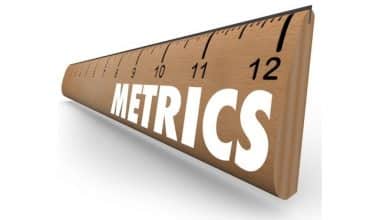When you execute a new business strategy, how do you tell whether or not your approach is working? The most widely known way to ensure that your strategy is successful is to classify success metrics before implementing your initiative.
Success metrics provide a quantitative way for your team to assess your advancement. By setting metric-based goals, you have the capability to determine whether or not your strategy is effective. While there are many distinctive main objective methods to select from, taking measurements of your improvements with success metrics is a commonality among them.
Success Metrics Meaning
The success metrics are a collection of standards established concurrently with the development of the service as critical elements that will determine the success of the project as a whole and of its eventual implementation.
Success metrics are quantifiable data used to assess the accomplishments of your business, sometimes used in conjunction with “key performance indicators” (KPIs). They are driven by formulas you create, which may account for nearly any data you feed Vitally, including product events, account and user traits, the total number of users in an account, and more.
Customer Success Metrics
A customer success metrics is a quantifiable indicator of the success of the customer as they adopt and utilize the product since it measures and evaluates the success of the customer success team. Although other industries also use some of the same measurements and vocabulary, SaaS and IT companies utilize these measures the most frequently.
How well you are serving your customers is assessed using customer success metrics. You can position your company as customer-centered and have a corporate philosophy of encouraging customer growth, but you still need to understand whether the product is actually improving the client’s daily tasks.
Customer success metrics aim to increase the value of the customer in order to produce recurring revenue. This entails sustaining and teaching the consumer continuously while adapting your business strategy to meet their unique needs. You can assess the success of your efforts using customer success metrics.
Project Success Metrics
Project success metrics are sets of data, algorithms, and calculations that enable businesses to gauge a project’s success. They assist managers and organizations in reviewing how a project is progressing, assessing team output, project completion deadlines, and expenses, as well as identifying, minimizing, or eliminating risks. Project success metrics are quantitative tools that companies use to design effective strategies, carry out ongoing improvement initiatives, and assess employee and customer attitudes.
Additionally, project success metrics are crucial since they demonstrate value and enhance performance, which eventually aids in business profitability. Data is the foundation of decision-making, and by utilizing project success metrics, you may more accurately forecast future outcomes or completely alter business plans. Project success metrics are essentially measurable, objective project-related characteristics.
The project deliverable success metrics were formerly the exclusive emphasis of the project success metrics. However, this outlook is changing at present and is dependent not just on project justification but also on user community approval and ROI. Additionally, project success metrics must be able to quantify the advantages of the project for the main business units.
Success Metrics Example
Without a goal, it is impossible to assess whether your performance is up to par. These ought to be established right away, ideally before you develop or alter your website. success metrics examples are as follows:
- regular weekly visits.
- average page visits for you
- Products sold each week or each month.
- number of new RSS feed subscribers each week.
- number of weekly new subscribers to newsletters or blogs.
- metrics for social media (i.e., number of new followers per month).
- average number of comments made on blog posts or other website content.
Measuring Success Metrics.
The following is a collection of typical metrics for measuring success metrics across several business platforms:
#1. Break-even Point
The break-even point measures how much a business needs to make each month or quarter in order to cover costs and remain afloat. Measuring success metrics and formulating actionable next steps requires keeping track of whether your business is meeting, exceeding, or falling short of this figure.
#2. Net Income Ratio
The money that is left over after a corporation deducts its costs from its revenue is known as the net income ratio, often known as profit. This metric has historically been used by businesses to gauge the value and can serve as a quick gauge of how well your business is doing.
#3. Recurring Monthly Income
If your company relies on a subscription-based model, tracking your monthly recurring revenue may be beneficial (MMR). This indicator refers to the company’s overall revenue over a given time period, often a month, broken down by specific items or services, the number of consumers who purchased them, and the number of customers who downgraded their monthly payments.
#4. Leads, Conversion, and Bounce Rate.
Monitoring the KPIs for these initiatives can be essential to guarantee their success if your company largely relies on marketing and advertising to drive sales.
#5. ROI and ROAS
The ratio of income to investment is known as return on investment (ROI). It is calculated by dividing the total revenue of your business by the cost of the goods or services sold, after which the result is subtracted from the total revenue.
#6. Clients
Customers are frequently the most obvious indicator of a business’s success. Measuring customer experience as a crucial indicator for long-term performance offers many businesses insightful information, and they significantly rely on the data surrounding brand-customer connections to track trends and develop sustainable policies. Metrics that measure these linkages from all angles have increased as a result of increased focus on the customer experience.
#7. Employee Contentment
The degree of contentment of your employees’ experiences in their roles is known as employee satisfaction. Employee happiness, a crucial statistic that is sometimes disregarded, strongly correlates to customer satisfaction, making it crucial for corporate success. Employee satisfaction can reduce turnover rates and the requirement for resource redistribution.
Student Success Metrics
Student success metrics involve integrating data-informed approaches that take into account students and their various contexts in order to have an effect on decisions that have an impact on the experiences and outcomes of students. It indicates academic achievements, participation in activities with an educational purpose, satisfaction, acquiring desired knowledge, skills, and competencies, tenacity, and achieved educational outcomes of students student success metrics are examined annually to guide decision-making and planning for ongoing improvement in services, community participation, instructional delivery, program outcomes, professional development, and student happiness. Also, student success measures are examined annually. As a result, the District develops objectives and programs in each of these areas that are pertinent to and consistent with its mission to encourage student success and serve its residents.
The data points that demonstrate the effectiveness of your social media strategy are known as success metrics for social media. Success metrics for social media are the foundation for continued growth and progress because they help you understand anything from how many people view your content to how much money you make from social media.
Monitoring success metrics for social media enables businesses to assess their performance in terms of brand exposure, conversions, user interaction with various types of content, and overall consumer satisfaction.
There is no one template or measurement to use to gauge your success on social media, but employing a variety of measures might give you a better understanding of how you are doing overall.
Certain social media metrics let you keep track of broad brand success recognition. They can display your overall reach as well as detailed demographic data about your intended audience segments or even specific users.
What Are the 4 Types of Metrics?
The following are four types of metrics, which apply to an entire organization, and also make up a good customer experience metrics system:
- Operational metrics
- Sensitive Metrics
- Behavioral Metrics
- Enterprise Metrics
What Is a Success Matrix?
Success Matrix is regarded as an analytical framework of success elements, their quantifiable indicators, and weightings (metrics) that are important and pertinent for the process of evaluating and prioritizing brownfields.
What Are Team Success Metrics?
Metrics that measure the performance of a team’s projects are called “team success metrics.” It assists businesses in tracking their progress, spotting obstacles and problems before they grow into bigger problems, organizing their efforts, and making knowledgeable decisions regarding ongoing and upcoming projects.
How Do You Measure Effectiveness?
Measuring effectiveness is a vital component of managing a team and ensures the company is working properly. Here are a few tips on how to measure effectiveness:
- Goal-oriented management
- Utilize the rating scales.
- Ask employees to rate their own level of job satisfaction.
- Performance as a team
- Peer evaluation
- External reviewers
- Quantity and excellence
- Cost efficiency
- Creativity
- Comments form
How Do You Measure Success at Work?
Here are a few more examples of how to measure success at work:
- Establish your essential values.
- Key questions to ask yourself include: How do you feel about what you’re doing?
- What are others saying about your work?
- Describe a plan
- Track digital traces and order tasks by significance.
- Make use of peer reviews.
How Can Managers Measure Success?
A manager can measure success by reflecting on these:
- Did I complete the projects I was engaged to complete?
- Where I stand in the project’s development.
- Updated updates on my performance evaluation and goal-setting list.
- how effectively I oversee the performance of my teams.
- My team’s accomplishment targets list.
- My project management abilities genuinely care about every part of it.
What Are the Five Performance Measures?
There are five different performance measures, and they are as follows:
- Input
- Output
- Efficiency
- Unit Price
- Quality
What is a success Matrix?
The brownfields assessment and prioritizing process uses the Success Matrix as an analytical framework for success elements, their quantifiable indicators, and weightings (metrics).
What are the 5 factors for success?
Strategic focus, people, operations, marketing, and finances are the five key success factors.
What are the 7 P’s to success?
This is my interpretation of the seven Ps, and I think that by concentrating on purpose, planning, product, pertinence, power, perception, and people, any business, whether it is just getting started or already established, or whether you are an entrepreneur, leader, or contributor, can significantly contribute to its success.
What are the 3 keys to success?
They are there. Communication, self-assurance, and character are the three keys to career success.
What are the KPI and success metrics?
KPIs assist your teams to concentrate on what’s important and support your strategy. A significant performance metric may be “targeted new clients per month,” for instance. Metrics assess how well routine business operations support your KPIs. Although they have an impact on your results, these are not the most important metrics.
What are the 4 P’s of success?
If certain fundamental concepts aren’t in place when those situations occur, they could be considerably more difficult to go through.
How success is usually measured?
Some of the most popular indicators of success are wealth, employment status, and happiness. Success must be measured properly in order to guide how time and resources are allocated.
Conclusion
Organizational leaders can assess success at both the individual and organizational levels by using success metrics. You can figure out what works and what doesn’t by using multivariate approaches to measure success across various aspects. The secret is to track development in relation to the organizational vision, mission, and overarching objectives.
FAQs On Success Metrics
What are the 4 types of metrics?
According to the researchers, only lead time, deployment frequency, mean time to restore (MTTR), and change fail rate are the four types of metrics
What are success metrics and KPI?
Your strategy and clear focus are defined by your key performance indicators. Metrics are your “business as usual” measurements that nonetheless contribute to the success of your company but aren’t the crucial ones you must meet. Although every metric is a KPI, not every KPI is a metric.
How do you define performance metrics?
Data from performance metrics is used to monitor business operations. Activities, employee behavior, and productivity are used as the main metrics to achieve this. Employers then use these indicators to assess performance. This relates to a specified objective like employee productivity or sales targets.






